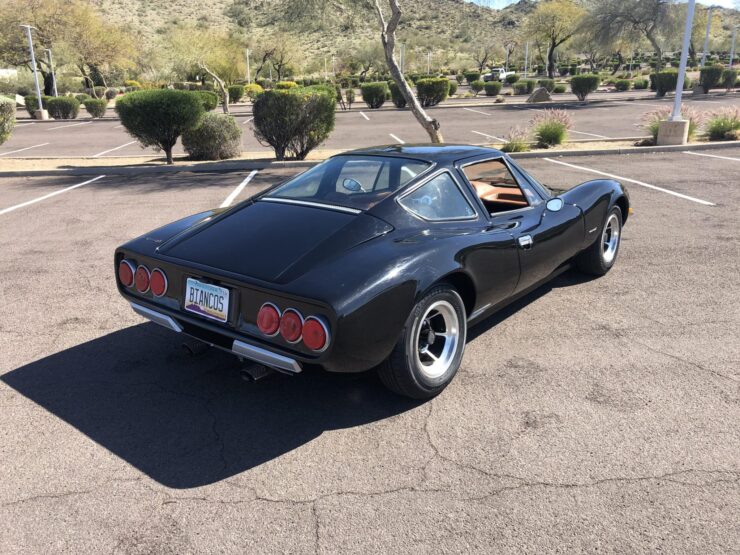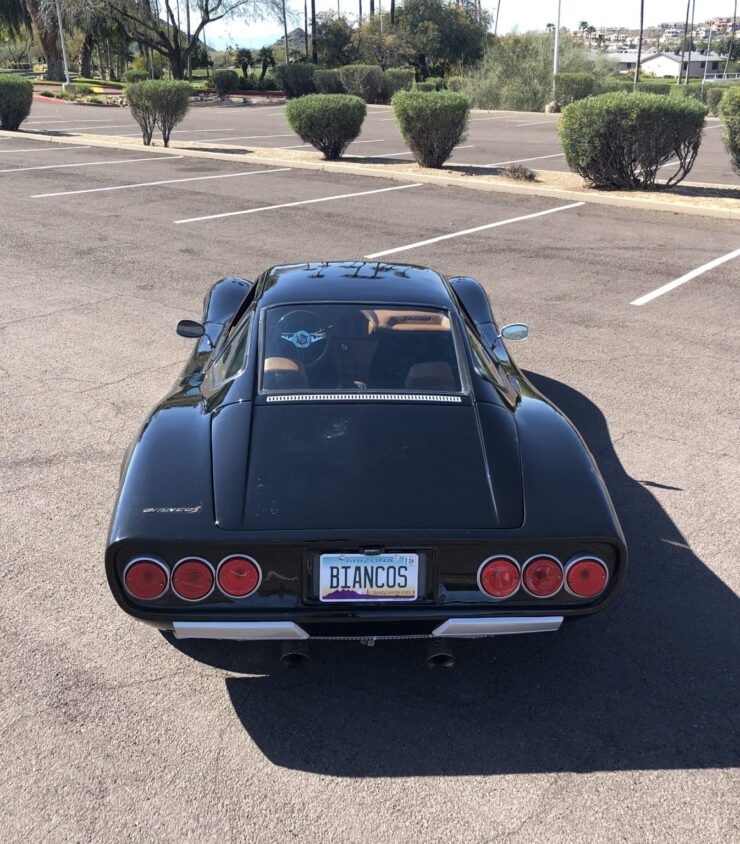This is a 1979 Bianco S, it’s a rare car in the United States and as a result many have never seen one before – either in person or in pictures. The car is one of the sports specials built by low-volume Brazilian automakers, fulfilling demand for locally-produced sports cars.
Historically, Brazil has had famously restrictive automotive import laws in the hopes of fostering a vibrant local car making industry. Overall, it does appear that the tactic worked, though for many years Brazilian people were starved of affordable sports cars – and a number of local firms sprang up to fill the void.
Fast Facts – The Bianco S
- The Bianco S is a rare Brazilian sports car built on a Volkswagen chassis. It was created in response to Brazil’s restrictive automotive import laws, which helped foster a local car-manufacturing industry. The Bianco S features a fiberglass body, VW mechanical components, and a distinctive design somewhat reminiscent of 1970s supercars.
- Ottorino “Toni” Bianco, an Italian immigrant to Brazil, founded the Bianco car company in the 1970s. He had a significant impact on Brazil’s racing and sports car scenes, designing the country’s first Formula 3 car. Bianco continued building unique cars well into his 80s, showcasing his lifelong passion for the industry.
- The Bianco S uses a 1600cc Beetle engine, producing 65 bhp with twin carburetors in the standard level of tune. It could achieve 0-62 mph in 17.7 seconds with a top speed of 91 mph. While not particularly impressive performance-wise, local tuning shops often significantly improved these figures. Approximately 320 units were produced before the company closed in 1979.
- The 1979 Bianco S Series 2 featured here is exceptionally well-presented. It has a black exterior, brown leather interior, power windows, and a wood-rimmed steering wheel. The car has been upgraded with a 1.9 liter VW flat-four engine, dual Weber-style carburetors, and is now being offered for sale in Phoenix, Arizona.
Building A Brazilian Sports Car Legend
There can be little argument that the Bianco S looks like an unusual 1970s-era supercar, with its low-slung body and sleek lines running front to back. Sadly, the performance isn’t quite there to match the appearance. As a sports car however, the car was one of the best produced in Brazil at the time, and examples could be seen entered into local race meets across both Brazil and more broadly across South America.


Brazil’s local automotive industry was kickstarted by Henry Ford, who opened the first major automobile factory in the country in 1921. This would cause ripple effects across the industry, and General Motors would open their first factory in Brazil five years later in 1926 so as to not be left behind – Brazil’s large population and fast growing economy made it almost a mirror of the United States on the South American continent.
Brazil’s import restrictions and hefty tariffs meant that sports car ownership was limited to a wealthy, privileged few, but the vast numbers of Volkswagen cars being manufactured in the country from 1959 onwards would soon provide a solution to this issue.
The platform chassis of the VW Beetle was designed from the outset to be affordable to produce and mechanically simple. It also benefitted from independent front and rear suspension, and a rear-mounted engine that was quite receptive to tuning for additional power and performance.
Countless companies have developed fiberglass bodied cars using the VW platform as a base, a usage case that Ferdinand Porsche could never have foreseen. The fact that the Beetle chassis is essentially a large skateboard with the engine, transmission, suspension, brakes, and steering all affixed made it relatively easy to fashion a fiberglass body that goes over the top.
And this is what happened in the United States, Canada, Brazil, Australia, and across Europe.
Ottorino “Toni” Bianco
Bianco had left his native Venice to move to Brazil in the years after WWII seeking opportunity in the fast-growing South American country. It would become his home for the rest of his life, and he would have a significant impact on the country’s formative racing and sports car scenes.
Above Video: This Brazilian short film shows Toni Bianco in his workshop, talking about his remarkable and lengthy history building sports and racing cars in Brazil. The film is in Portuguese however you can turn on closed captions (CC) and auto translate to follow along with what he’s saying.
The first Formula 3 car ever made in Brazil was said to have been designed and built by Toni Bianco, he had earlier designed a number of other open and closed-wheel racing cars in the country.
When he had first immigrated to Brazil as a young man he worked in banks and as a laborer building wooden houses, until he was fatefully employed by a mechanical workshop in the traditional Italian neighborhood of Bela Vista in São Paulo.
This involvement with repairing and rebuilding cars would transform Bianco’s life, and though he didn’t know it at the time he would still be building cars 60 years later.
In the 1970s he founded his own namesake sports car marque, Bianco, to produce a small number of cars on the Beetle platform. The three primary models were the Bianco S, the Bianco 2 Series, and the Bianco Tarpan – of these the Bianco S was produced in the highest numbers.
Bianco closed down in 1979 but the company’s founder never tired of building unusual cars, as late as 2018 he was still at it, building his own mid-engined sports car in his garage at the age of 86.
The Bianco S
The Bianco S is a two-door, rear-engined sports car based on the Beetle chassis. It keeps the suspension, brakes, engine, steering, and transmission from the VW, coupling it with a new fiberglass body with some additional steel reinforcement at the sides and front for safety.


If those unusual quad headlights look familiar to you it may be because they were sourced from the Volkswagen Variant, and they’re the same headlights used by the Volkswagen SP2 – another locally-built Brazilian sports car.
The fit and finish of the Bianco S is good, certainly by the standards of a VW-based sports car in the 1970s. It has twin bucket seats, a carpeted interior with vinyl upholstery, a laminated windscreen, a wood-rimmed steering wheel, and a custom dashboard and upholstery.
Many examples of the car have the 65 bhp Beetle engine fitted with twin carburetors and a 4-speed manual transaxle, making it capable of 0 – 62 mph in 17.7 seconds and a top speed of 91 mph (146 km/h).
These aren’t particularly impressive performance figures, however local Brazilian tuning garages have significantly improved the performance of these cars over the years, and larger higher-performance engines are commonly swapped into them.
At the peak of production it’s said that 20+ were being built each week, a significant number for such a small manufacturer. By the end of production 320 had been made, it’s not known exactly how many have survived but they’re now a popular and collectible car in Brazil, elsewhere in the world they remain largely unknown.
The 1979 Bianco S Series 2 Shown Here
The car you see here is probably the best-presented example of the Bianco S that we’ve featured. It’s finished in black and it has a fully upholstered diamond-stitched brown leather interior, power windows, a wood-rimmed Rosseti sports steering wheel, and Bianco-branded instrumentation.


The car rides on 13″ Roda Gaucha Aro wheels fitted with 185/70 Westlake Radial P18 tires, and it has front disc and rear drum brakes. Power is provided by a 1.9 liter VW flat-four which has been upgraded with dual Weber-style carburetors, high-flow air filters, and tubular headers. The engine sends power back through a 4-speed manual VW transaxle to the rear wheels.
Relatively few examples of the Bianco S have made their way into the United States, though fortunately this car is one of them, and it’s now being offered for sale out of Phoenix, Arizona on Bring a Trailer. If you’d like to read more about it or place a bid you can visit the listing here.
















Images courtesy of Bring a Trailer








